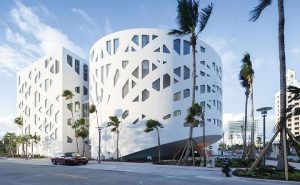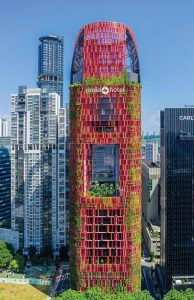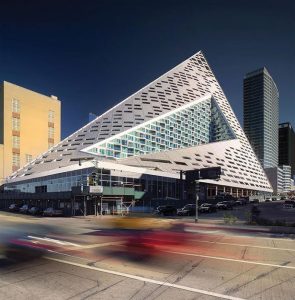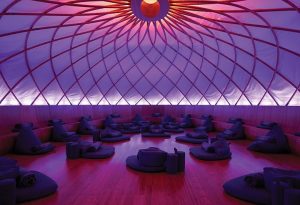A Look at Today’s Modern Architecture
by Michael Scivoli
In the world of design, there’s an ongoing debate of whether architecture, at its essence, is considered art. To some, the answer to this question is simple, as many of us view anything involving self-expression as art. For others, they recognize that architects themselves, while in charge of a project’s inception and aesthetic, aren’t the ones who actually control the form of the built environment. But whatever our views, the wise words of Winston Churchill seem to stand the test of time: “We shape our buildings; thereafter they shape us.” And as the face of modern architecture grows each year—from sustainable building materials and imaginative designs, to cutting-edge technology and mesmerizing shapes—every new structure is more impressive than its predecessors. The projects featured here are representational of the most exotic geometries and forward-thinkers in architecture today.
Antwerp Port House
Location: Antwerp, Belgium
Architect: Zaha Hadid Architects
Scale: 220,000 square feet
Photo by Helene Binet
Perhaps the biggest statement in the world of architecture and design is Zaha Hadid’s Antwerp Port House. The new structure repurposes a deserted fire station into a new HQ for the port community. Completed in 2016, the Port House no doubt puts Antwerp Port Authority near the top of the world’s best designs. Its unique geometry is a symbol of the innovative characteristics of the Port of Antwerp. The structure itself, which is over 13 stories tall, houses 500 employees and serves as a point of contact for the many international contacts of the Antwerp port. Similar to the shape of a bow of a ship, the Port House’s glassed surface glistens and ripples, reflecting the colors of the water and sky that surround it.
 Faena Forum
Faena Forum
Location: Miami, FL
Architect: OMA
Scale: 43,000 square feet (6,700-square-foot performance hall)
Photo by Iwan Baan
Miami’s Faena District is no stranger to art, and just walking around this distinctive area is nothing short of an immersive journey. Serving as the backbone of cultural affairs in this district, the Forum is an epicenter for the surrounding community and mid-beach zone. Opening last year just in time for Art Basel, this structure and its subsidiaries are as symmetrically pleasing as they are innovative. The Forum itself, located along Collins Ave, was designed as an ensemble of large versatile spaces, able to meet the needs of various happenings from concerts to pop-up culinary events. In addition, the Faena Forum also houses traditional art galleries and features a plaza with a 46-foot cantilever.
 Oasia Hotel Downtown
Oasia Hotel Downtown
Location: Singapore
Architect: WOHA
Scale: 210,000 square feet
Photo by K. Kopter
Soaring at 27 stories, the Oasia Hotel Downtown is more than just a hospitality focal point, it’s a colorful icon that makes itself known in its urban environment. The project, which cost an estimated $138 million, was designed by WOHA, a Singapore-based architectural practice which has garnered international fame for their devotion to integrating environmental principles in their design processes. Different from the traditional grey, steel skyscrapers of old, the Oasia Hotel is a sleek alternative which embodies life in the urban tropics.
 VIA 57 West
VIA 57 West
Location: New York, NY
Architect: Bjarke Ingels Group
Scale: 831,000 square feet
Photo by Nic Lehoux
VIA 57 West brings a new perspective to Manhattan’s skyline with its angular chic look while giving back to the environment. Taking a 360-degree view around this building presents dramatically changing dimensions from a pyramid-style look to a glass spire. The sun-draped and Copenhagen-simulated courtyard provides spectacular views of the Hudson River with adjacent views of Helena 57 West. The structure features south-facing terraces, unique patterned walls resembling fishbone and bay windows located in every apartment. The design and residences mark the perfect balance between serenity of nature and excitement of Manhattan.
 Inscape NY
Inscape NY
Location: New York, NY
Architect: Winka Dubbeldam
Scale: 5,500 square feet
We don’t often associate architecture with meditation and yoga, especially when you consider the hastey vibe of Manhattan. But tucked in New York’s Flatiron District is Inscape, a meditation and relaxation studio. The space features a honeycomb-like pattern of bamboo and ambient lighting which helps bring out the architectural brilliance of the project. With a mission to empower and connect with one’s inner self, Dubbeldam worked with founder Khajak Keledjian to create a one-of-a-kind space that’s reminiscent of 4th century monasteries and a soothing temple.
The post Framing the Future appeared first on VUE magazine.
